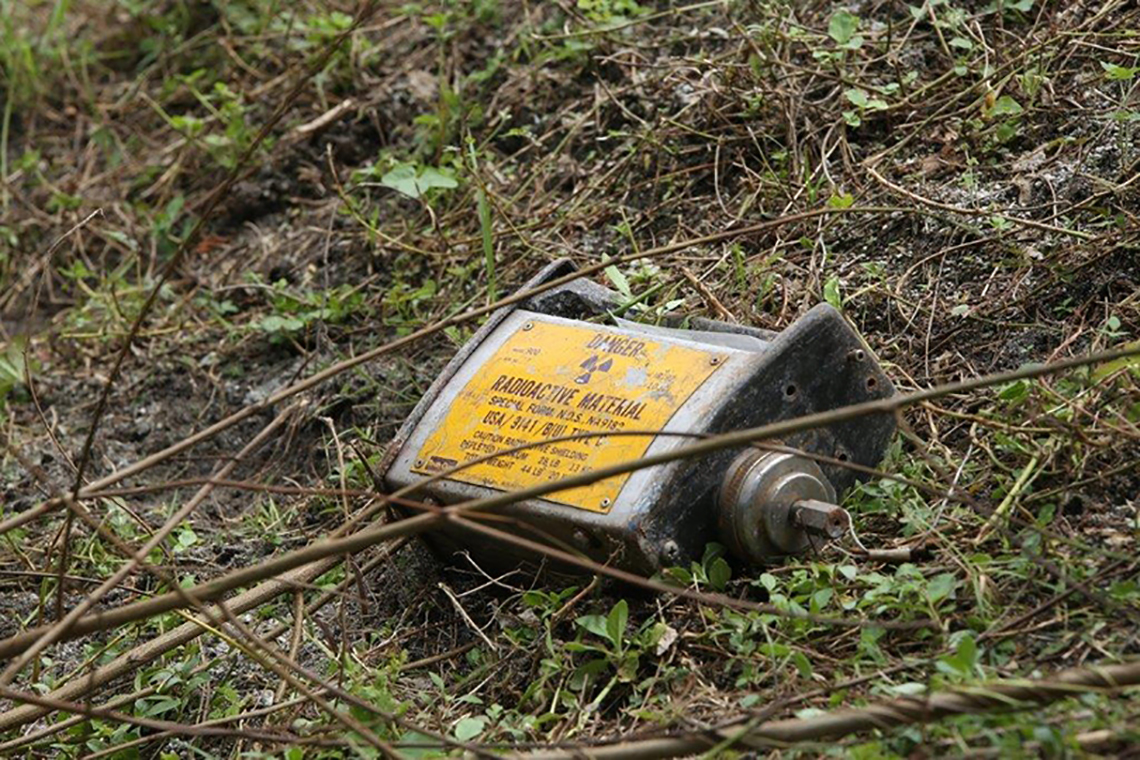
If you would like to learn more about the IAEA’s work, sign up for our weekly updates containing our most important news, multimedia and more.
Incident and Trafficking Database
Combating illicit trafficking of radioactive materials for 25 years
Charlotte East, Kendall Siewert

An orphaned radioactive source. (Photo: PNRI and IAEA)
If radioactive material is lost or stolen, the IAEA’s Incident and Trafficking Database (ITDB) can help authorities improve the chances of the material’s recovery, reducing the risk that it will fall into the wrong hands. For the past 25 years, the ITDB has played an important role in fostering international cooperation and information sharing towards enhancing nuclear security globally.
The ITDB catalogues voluntarily reported information related to lost or stolen nuclear and other radioactive material. This ranges from the smuggling and sale of nuclear material, to the unauthorized disposal and the discovery of lost radioactive sources. Incidents reported to the ITDB involve radioactive materials such as uranium, plutonium and thorium, as well as naturally occurring and artificially produced radioisotopes, and radioactively contaminated material.
“ With over two and a half decades of data, we have a huge volume of information to learn from to help strengthen nuclear security in the future.
Over 3500 incidents have been reported since the database’s inception in 1995, around 10% of which have been confirmed as acts related to trafficking or malicious use. The rest have been incidents of undetermined intent or unconnected with trafficking or malicious use. In the past 10 years, over 250 incidents of theft of radioactive sources have been reported to the ITDB, with around one third of these sources being subsequently reported as unrecovered, with their whereabouts unknown.
The number of incidents involving the most serious kinds of nuclear material has significantly decreased in the last two decades, according to Scott Purvis, Head of the Information Management Section in the IAEA’s Division of Nuclear Security. However, individuals continue to attempt to illegally trade a variety of other nuclear and radioactive materials. Over the past five years, an average of six such incidents per year have been reported to the ITDB, including scams that turned out to be non-radioactive material. The occurrence of these incidents demonstrates that individuals remain willing to smuggle and illicitly trade radioactive material.
Information sharing
One of the key functions of the ITDB is to encourage information sharing on relevant nuclear security events among the 139 participating countries. Details of reported incidents are shared with national points of contact and a small number of relevant staff at the IAEA and certain international organizations such as the International Criminal Police Organization — INTERPOL. This information can then assist authorities with identifying and recovering material that is lost or stolen, strengthen national detection and response arrangements and, in some instances, help make connections between cases.
“Information exchanged through the ITDB can help authorities evaluate an incident and can open the door to identifying and establishing possible connections between incidents, whether they are local or in different countries,” Purvis said. “This can then facilitate cooperation to support further investigation.”
One example of such cooperation occurred in 2017, when a submission to the ITDB regarding a stolen device with a radioactive source prompted a joint investigation between two countries. As a result, an inspection team was able to locate the device on the premises of an engineering company in a different country. The device was consequently recovered, confirmed to be in good condition and then repatriated to its country of origin and to its rightful owner. Also revealed during the investigation was how the engineering company — which was charged with the criminal offense of dealing stolen goods — acquired the device.
Analyzing data
Tapping into over 25 years of information, ITDB users can review all incidents in the database with a view to identifying common threats, trends and patterns, which can shed light on criminal activities involving radioactive material and help countries identify areas for strengthening nuclear security. One such pattern identified through analysis has shown that around 50% of thefts reported to the ITDB involve material in transport. This has resulted in many countries enhancing radioactive material detection systems at their borders.
“Analyzing information in the ITDB gives us important insights, such as the types of materials being trafficked, any regions that may be particularly affected or patterns of activity. With over two and a half decades of data, we have a huge volume of information to learn from to help strengthen nuclear security in the future,” Purvis said. “This can assist countries in determining the appropriate course of action to enhance detection and prevention efforts.”
For example, in 2018 and 2019, a series of reports to the ITDB helped authorities identify which systems and measures to strengthen regarding radioactive sources in scrap metal; if an item containing radioactive material is improperly disposed of or erroneously sent for recycling, it may be unknowingly melted and could contaminate the scrap metal product.
In this reported case, potentially dangerous radioactive sources were found in scrap metal containers in Northern Europe. All sources were recovered and have since been stored safely at the country of origin’s national radioactive waste facility. While the case is still ongoing and the details are confidential, reported information led to the conclusion that there is a serious possibility of more similar sources turning up in scrap metal containers in the future.
“The success of the ITDB is due in large part to the contributions of incident reports by participating countries over the past 25 years. With their ongoing support, the ITDB will continue to strengthen global efforts to combat the illicit trafficking of nuclear and other radioactive material through international cooperation and information exchange,” Purvis said.


